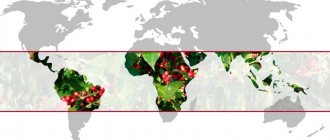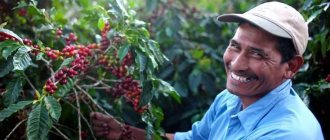This article is the personal experience of one of the authors of our blog, who visited a coffee plantation in Papua New Guinea 20 years ago, but the memories are still fresh. And after this trip her world turned upside down.
A word from our journalist: only pure emotions, only hardcore – without edits and almost without censorship.
“Where are you going? – my parents asked in bewilderment back in 1997. – Which Papua New Guinea? Do you even know where it even is? Listen, we have a psychiatric hospital not far from our house, maybe you can get checked?”
This was roughly the reaction to my upcoming departure. I must say, they were not far from the truth: a normal person would really have thought a hundred times whether it was worth going to this “stone age”, but I found out about this a little later, on a coffee plantation near Mount Hagen (five streets, five bars). two, both with barred windows, white people - about 150 people). This is the capital of the Western Highlands (the population at that time was about 300 thousand people for the entire region). I tell you what I saw there and why my eyes were square for a long time.
1. Landing
The coffee bean is actually a seed. It is used to brew coffee after drying, roasting and grinding. Untreated seeds can be planted and grown into a coffee tree. Coffee seeds are usually planted in large beds in shady nurseries.
Nursery
In the nursery, the seeds should be kept moist and mixed with manure. The seeds must then germinate for 2-3 months under constant watering before planting in the coffee beds.
The seedlings are watered frequently in a shady area out of bright sunlight until they are strong enough to be planted permanently. Planting often occurs during the wet season, so the soil remains moist and the roots are firmly established.
nursery
Compost (manure)
Adding compost between coffee plants is a very important activity. Because coffee plants are not placed on a flat surface, the compost between the rows helps retain rainwater between the plants, which is important for nutrition. Otherwise, the water will "flow" down the slopes and therefore the coffee seedling will not receive enough water and nutrients.
Before compost is added between the rows, it must sit for seven months and dry out. It should not be too fresh for the plant.
Compost rows are selected according to the gradient of the coffee-covered soil.
Thus, compost has 2 benefits: it is both a source of nutrients and prevents soil erosion. Compost is added to every third row.
coffee bushes
Flowering coffee tree
Each flower on a coffee tree is a sign that a coffee cherry will grow in a few months. Flowering marks the beginning of the coffee tree's harvest season.
With proper tissue management, blooms can be achieved twice a year. In Africa, the first flowering occurs in the middle of the year (May-June). The second and main flowering occurs at the end of the year (October-November), and this is the main harvest.
bloom
Flowering is a sign that the shoots will bear fruit. If the farmer prepares early by pruning and growing side shoots in December or January to retain or get new branches, and then if given the right nutrition in terms of fertilizer and manure, the farmer will get a good harvest in March, which means a good early harvest in May.
About two months after flowering, green coffee cherries begin to appear on the coffee tree.
coffee fruit
Trimming
Pruning helps maintain good quality by removing excess branches. The main branch should have 4-6 branches. If there are more, the extra branches will require the nutrients the cherry needs, reducing their quality.
Chemicals for coffee
Only about 10% of the world's coffee farms are fully organic. However, chemicals can improve performance. On the other hand, too much chemicals can cause them to remain in the bean and even make the coffee taste phenolic (= really chemical taste). But the right amount of chemicals will increase productivity without negatively affecting the taste of the coffee.
coffee cherries
Earth's Coffee Belt
Coffee trees grow in 65 countries around the world. Almost all of them are represented on the foreign market.
Coffee is a capricious plant, and its distribution has its own characteristics.
- If you map all the countries where coffee is grown, it is easy to see that they are located along the equator. This strip is called the Earth's coffee belt.
- The distribution width of coffee crops is limited to 10 degrees south latitude and 10 degrees north latitude. For those familiar with geography, we add that the regions where the crop is grown lie in the Tropics of Cancer and Capricorn.
- This geography is not something mystical or special. It's all about the climate. Coffee trees require a humid and warm atmosphere, and most importantly, the absence of strong temperature changes and night frosts. A sharp drop in temperature is detrimental to delicate plants.
- The mild and even equatorial climate is ideal for growing the crop. Born in Ethiopia, it gradually spread throughout the world, taking root in regions whose geography was similar to its historical homeland.
The main coffee growing regions are Central Africa, South and Central America, and Southeast Asia.
Harvesting
Depending on the variety, it will take 3 to 4 years for newly planted coffee trees to bear fruit. The fruit, called a coffee cherry, turns a bright dark red when it is ripe and ready for harvest. Typically, a coffee tree produces one main harvest per year. In countries like Colombia, where the tree produces two blooms each year, there is a main and a second harvest. In most countries, the crop is harvested by hand through a labor-intensive and complex process, although in places like Brazil, where the landscape is relatively flat and the coffee plantations are huge, the process is mechanized. All coffee, whether by hand or machine, is harvested in one of two ways:
Continuous picking: all the fruits are removed from the branch at the same time, either by machine or by hand.
Selective picking: Only ripe cherries are picked by hand first. Pickers walk the trees every 8-10 days, choosing only cherries that are at the peak of ripeness. Because this type of harvesting is labor intensive and more expensive, it is used primarily to harvest the finest Arabica beans. A good picker averages 100 to 200 pounds of coffee cherries per day, yielding 20 to 40 pounds of coffee beans. Each picker's daily haul is carefully weighed, and each is paid according to his or her volume of work. The day's harvest is then transported to the processing plant.
coffee berry picking
Where is the most coffee grown?
Coffee grows in many countries, but only a few provide the main supply to the world market.
- Brazil - 30%
- Vietnam - 17%
- Colombia - 12%
- Ethiopia - 6%
- Indonesia - 5%
- India - 4%
The total share of these countries accounts for over 70% of world coffee cultivation and exports. Most industrial supplies of grains are used for the production of mixtures and blends. Therefore, anyone who drinks espresso or buys ready-made blends can safely say that they have tasted coffee grown in Colombia, Brazil or Africa.
Coffee processing
Once the coffee is harvested, processing should begin as quickly as possible to prevent spoilage of the fruit.
Depending on the location and local resources, coffee is processed in one of two ways:
The dry method is a centuries-old coffee processing method and is still used in many countries where water resources are limited. Freshly picked cherries are simply laid out on huge surfaces to dry in the sun.
To prevent the cherries from spoiling, they are raked and turned over during the day, and covered at night or during rain to prevent them from getting wet. Depending on the weather, this process can continue for several weeks for each batch of coffee until the moisture content of the cherries drops to 11%.
The wet method is used to remove the pulp from coffee cherries after harvesting, so the beans are dried only on the remaining parchment peel. First, freshly picked cherries are put through a hulling machine to separate the skins and pulp from the grains.
The beans are then separated by weight as they pass through the water channels. Lighter beans float to the top, while heavier, ripe beans sink to the bottom. They are passed through a series of rotating drums that separate them according to size. After separation, the grains are transported to large, water-filled fermentation tanks.
Depending on a combination of factors—such as the condition of the beans, climate, and altitude—they will remain in these tanks for 12 to 48 hours to remove the slippery layer of mucilage (called parenchyma) that is still attached to the parchment. Resting in the reservoirs, natural enzymes will cause this layer to dissolve. When fermentation is complete, the grains become rough to the touch. The grains are washed through additional water channels and are ready for drying.
wet method
Drying coffee beans
If the grains have been wet processed, the hulled and fermented grains must be dried to about 11% moisture content to properly prepare them for storage. These grains, still inside the parchment shell (endocarp), can be dried in the sun, spread on drying tables or floors where they are regularly turned, or they can be dried by machine in large drum dryers. The dried beans are known as parchment coffee and are stored in jute or sisal bags until ready for export.
coffee bean processing
Cleaning grains
Before export, parchment coffee is processed as follows:
The huller removes the parchment layer (endocarp) from wet processed coffee. Dry processed coffee processing means removing all the dried husks—exocarp, mesocarp, and endocarp—from the dried cherry.
Polishing is an optional process in which any silver skin remaining on the beans after hulling is removed by machine. While polished grains are considered superior to unpolished grains, there is actually not much difference between the two.
Grading and sorting is done by size and weight, and the grains are also checked for color defects or other imperfections.
The grain is measured by passing through a series of screens. They are also sorted pneumatically using an air jet to separate heavy and light grains.
Typically, grain sizes are presented on a scale of 10 to 20. The number represents the diameter size of a round hole in units of 1/64 inch. No. 10 grit is an approximate hole size of 10/64 inches in diameter, and No. 15 grit is 15/64 inches in diameter.
Finally, defective grains are removed manually or using equipment. Grains that are unsatisfactory due to deficiencies (unacceptable size or color, fermented grains, insect damaged, untreated) are removed. In many countries, this process is performed either by machine or by hand, ensuring that only the highest quality coffee beans are exported.
drying
Sorting
Grading is important during the drying process of coffee beans to remove any visible defects such as over-ripe, unripe (when roasting, over-ripe and under-ripe beans turn into so-called quakers (unripe coffee beans)), insect damage and foreign objects such as husks and cherry husk. Sorting improves the purity of the coffee, which results in a better cup of coffee and better pay for the farmer.
sorting
Export of coffee beans
The cleaned, sorted and polished beans, now called green coffee, are loaded onto ships in jute or sisal bags loaded into shipping containers, or transported in bulk in plastic-lined containers. According to the USDA, global coffee production is projected to be 169.33 million 60kg bags in 2019/20.
coffee beans
Asia-Pacific coffee region
The Asian-Pacific region includes, quite conditionally, the Australian continent. About two dozen countries cultivate coffee beans in this region of the Earth. Coffee from India is distinguished by the characteristics of trade winds and monsoon rains. The La Semuz company has a selection of inde plantation coffee, recommended for lovers of single-origin coffees. This part of the coffee belt produces rare varieties of coffee, in particular Kopi Luwak. Interesting from the point of view of coffee lovers and, at the same time, adherents of environmentally friendly products, are coffee beans from the island of Timor, located between the states of East Timor and Indonesia.
Coffee tasting
Coffee is repeatedly tested for quality and taste. This process is called cupping and usually takes place in a room specifically designed for the process.
First, a coffee taster—commonly called a cupper—rates the beans for their overall visual quality. The beans are then roasted in a small laboratory roaster, immediately crushed and infused in carefully controlled boiling water. The cupper sniffs the drink to sense its aroma, an important step in assessing the quality of the coffee.
After the coffee has been steeped for a few minutes, the cupper removes the surface layer on the cup. Again, the coffee is sniffed before tasting begins.
To taste the coffee, the capper quickly swallows the spoon, inhaling quickly. The goal is to spray the coffee evenly onto the cup's taste buds and then linger on the tongue for a bit before spitting it out.
Samples from different batches and different beans are sampled daily. Coffee is not only analyzed to determine its characteristics and deficiencies, but also to blend different beans or create the right roast. An experienced coffee cupper can taste hundreds of coffees a day and still be able to sense the subtle differences between them.
tasting
Coffee roasting
Roasting turns green coffee into the aromatic brown beans we buy at our favorite stores or cafes. Most fryers maintain temperatures around 550 degrees Fahrenheit. The beans are turned throughout the process to prevent them from burning. When they reach an internal temperature of about 400 degrees Fahrenheit, they begin to brown and the caffeol, the flavorful oil found in the beans, begins to appear. This process, called pyrolysis, is at the heart of roasting—it produces the flavor and aroma of the coffee we drink. After roasting, the beans are immediately cooled in air or water. Roasting is usually carried out in importing countries, since freshly roasted beans need to reach the consumer as quickly as possible.
coffee cherry
How and when coffee came to Papua New Guinea
Europeans brought coffee to the country - they began to cultivate the local wild places around the end of the century before last. This had almost no effect on the inhabitants: most of them continued to live in tribes, speak different dialects, and subsist on hunting and gathering.
From this point of view, growing and collecting coffee for the tribe is even beneficial: there is no need to eat neighbors, because the borders of the plantations are guarded, and there is still protection from animals. Well, the diet turns out to be more varied and interesting than that of our ancestors, and there is no need to wade through the evergreen jungle. Almost like a resort, right?
Coffee beans LavAzza “Qualita Oro”, 500 g 752 rub.
Lavazza “Qualita Oro” coffee beans, 250 g 351 rub.
Compagnia Dell'arabica "Jamaica Blue Mountain" bean coffee, 1500 g 48,960 rub.
Coffee beans Paretto “Celesto”, freshly roasted, 1000 g 1619 rub.
Coffee beans Jockey “Traditional”, 100 g 71 rub.
Bean coffee Bushido “Red Katana”, 1000 g 1921 rub.
Coffee beans Lavazza “Qualita Oro”, 1000 g 1550 rub.
Coffee beans Lavazza “Gran Crema Espresso Barista”, 1000 g 1400 rub.
Coffee beans from 30 countries on TEA.ru
With the help of such free labor, many plantations were cleared in the mountains. The climate here can generally be considered greenhouse: about +28 °C and humid all year round. So by the 1920s, coffee production had reached a completely industrial level. It turned out that coffee is a profitable business (an impressive 13% of exports) even against the backdrop of oil and gold - the main sources of income for a small but proud country.
It is curious that the finest hour of Papuan coffee and the point of entry onto the world stage happened at the time of the crisis of the Brazilian coffee industry in 1975. Considering that the same year brought independence to the Papuans, how can one dismiss the idea of a conspiracy theory?
Coffee grinding
The goal of proper grinding is to get the maximum flavor out of your cup of coffee. How coarse or fine a coffee grind to use depends on the brewing method. The length of time the ground coffee is in contact with the water determines the ideal grind level.
As a general rule, the finer the grind, the faster the coffee should be prepared. This is why ground coffee for an espresso machine is much better than coffee made in a drip system.
Espresso machines use 132 psi of pressure to extract the coffee. It is recommended to take a moment to examine the beans and smell their aroma - in fact, only the smell of coffee has an energetic effect on the brain.
Espresso - delicious coffee in Rome, Italy
Roman cafes desperately resist technological progress. They prefer to brew coffee the old fashioned way without newfangled devices. Perhaps this is why Italy has the largest number of winners of coffee competitions and competitions.
Baristas create real masterpieces. They say that the art of making pictures in coffee cups originated in Rome.
Sitting on the square by the fountain of the eternal city, sipping strong coffee at a small table, is a special pleasure.
What to order: Espresso
It is customary to drink coffee with milk here only for breakfast.











